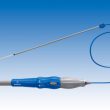Patients who receive chronic anticoagulation therapy and then undergo angioplasty are frequently discharged on a triple anti-thrombotic scheme that usually includes aspirin, clopidogrel, and warfarin. The optimal duration of this indication remains unclear, particularly for patients at high bleeding risk. According to expert consensus, patients receiving chronic anticoagulation may receive from 1 to 12 months of dual<a href="https://solaci.org/en/2017/09/08/polymer-free-des-also-show-efficacy-in-anticoagulated-patients-with-high-risk-for-bleeding/" title="Read more" >...</a>
COMPASS: A New Place for Rivaroxaban in Chronic Ischemic Heart Disease
Combining low doses of rivaroxaban and aspirin seems to be the best strategy for patients with stable chronic ischemic heart disease, according to this new study presented at the European Society of Cardiology Congress 2017, which was published simultaneously in the New England Journal of Medicine. Compared with low-dose aspirin alone, the combination of aspirin<a href="https://solaci.org/en/2017/09/07/compass-a-new-place-for-rivaroxaban-in-chronic-ischemic-heart-disease/" title="Read more" >...</a>
Positive Outcomes of CoreValve Evolut in Large Population
The Evolut R, as well as its predecessor the CoreValve, is a self-expandable valve, supra-annular, made of porcine pericardium in a nitinol frame. Amongst its improvements, it has a better profile and the option to resheath. This makes it fully repositionable and even recapturable. We only needed to confirm these technical advantages would translate into clinical<a href="https://solaci.org/en/2017/08/30/positive-outcomes-of-corevalve-evolut-in-large-population/" title="Read more" >...</a>
A Simple Electrocardiography to Predict Mortality in TAVR
Conduction abnormalities, such as new left bundle branch block, atrioventricular block, and need for a pacemaker, are still among the most frequent complications in transcatheter aortic valve replacement (TAVR). New valve generations have (mostly) not managed to reduce significantly electrical abnormalities; furthermore, some modifications such as external skirts, which are extremely effective for the reduction<a href="https://solaci.org/en/2017/08/29/a-simple-electrocardiography-to-predict-mortality-in-tavr/" title="Read more" >...</a>
Lotus vs Sapien 3, different mechanisms with similar results
The new generation devices for transfemoral transcatheter aortic valve replacement have been optimized to improve valve position and reduce residual aortic regurgitation. This study compared 30 day, 12 month and 24 month outcomes of the repositionable, Lotus valve, with controlled mechanical expansion, and the balloon-expandable valve Edwards Sapien 3. Primary end point was all cause mortality<a href="https://solaci.org/en/2017/07/26/lotus-vs-sapien-3-different-mechanisms-with-similar-results/" title="Read more" >...</a>
MRS vs. DES: Which one is associated with better long-term quality of life?
The SYNTAX (Synergy Between Percutaneous Coronary Intervention With Taxus and Cardiac Surgery) trial, which included patients with 3-vessel or left main coronary artery lesions, showed that myocardial revascularization surgery (MRS) turned out to be superior to angioplasty with drug-eluting stents (DES), mainly due to differences in acute myocardial infarction and repeat revascularization. Up to this work, patient sensations (which can be<a href="https://solaci.org/en/2017/07/21/mrs-vs-des-which-one-is-associated-with-better-long-term-quality-of-life/" title="Read more" >...</a>
Post-dilation in TAVI associated to more stroke and more paravalvular regurgitation
Courtesy of Dr. Carlos Fava. Moderate/severe paravalvular regurgitation (PVR) after TAVR is present in 10%-14% of all cases, according to different series. The treatment of choice is post-dilation, generally effective in most cases. However, this strategy carries a risk of stroke. The true impact of this conduct is still unclear. This review analyzed 6 studies that included 5007 patients; 889 of<a href="https://solaci.org/en/2017/07/10/post-dilation-in-tavi-associated-to-more-stroke-and-more-paravalvular-regurgitation/" title="Read more" >...</a>
Progress of patients with hypertrophic cardiomyopathy treated with alcohol septal ablation
Courtesy of Dr. José Álvarez. Alcohol septal ablation (ASA) for the treatment of obstructive hypertrophic cardiomyopathy (OHC) is a procedure introduced in 1995 as an alternative to surgical myectomy. The American College of Cardiology (ACC)/American Heart Association (AHA) guidelines indicate that ASA should be reserved for older patients with comorbidities, thus establishing surgical myectomy<a href="https://solaci.org/en/2017/06/28/progress-of-patients-with-hypertrophic-cardiomyopathy-treated-with-alcohol-septal-ablation/" title="Read more" >...</a>
SENTINEL study: cerebral protection during TAVR
Neurological complications during and after transcatheter aortic valve replacement (TAVR) are probably the only event whose incidence has not been reduced by new valve designs (as opposed to paravalvular leak, vascular complications, or need for pacemaker implantation). Aside from the potential seriousness of this clinical event, the risk of embolism is particularly worrisome because,<a href="https://solaci.org/en/2017/06/15/sentinel-study-cerebral-protection-during-tavr/" title="Read more" >...</a>
In-hospital morbid-mortality rates for balloon aortic valvuloplasty are similar to those for transcatheter aortic valve implantation
Courtesy of Dr. Carlos Fava. The balloon aortic valvuloplasty (BAV) was introduced by Dr. Cribier in 1986. However, given its poor results, soon after it fell into disuse. With the introduction of TAVR, it saw a revival as bridge for another intervention, even though it is still resisted in many places. The present study<a href="https://solaci.org/en/2017/06/07/in-hospital-morbid-mortality-rates-for-balloon-aortic-valvuloplasty-are-similar-to-those-for-transcatheter-aortic-valve-implantation/" title="Read more" >...</a>









